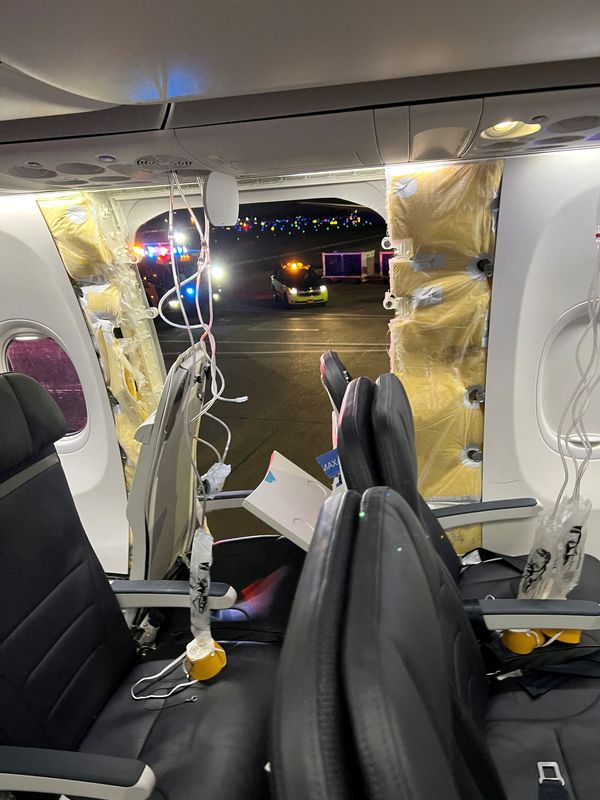(Reuters) - A piece of fuselage tore off the left side of an Alaska Airlines-operated Boeing (NYSE:BA) 737 MAX 9 jet as it climbed following takeoff from Portland, Oregon, en route to Ontario, California, forcing pilots to turn back and land safely with all 171 passengers and six crew on board.
The panel that tore off is a plug put in place on some MAX 9s instead of an additional emergency exit, but not every plane is manufactured in such a way.
WHAT HAPPENED?
As Alaska Air (NYSE:ALK) Flight 1282 reached just over 16,000 feet on Friday, the panel tore off from the side of the jet, leaving a neat, refrigerator-sized, rectangular hole in the aircraft. The pilot immediately signaled that the plane would have to land.
WHY IS THIS PANEL THERE?
The 737 MAX 9, currently Boeing's largest single-aisle plane, can seat up to 220 people. It includes an optional extra door to allow for the approved number of evacuation paths whenever carriers opt to install the maximum number of seats.
Planes that do not opt for additional seating can replace that door with a panel, or plug. Door plugs have been used to adapt aircraft and offer flexible layouts across the industry for years.
HOW MANY OF THESE PLANES ARE THERE?
Of the 200-plus 737 MAX 9 planes Boeing has delivered, 171 have this panel in place of a door. In the United States, the carriers using that panel are United and Alaska. Other carriers that have grounded planes include Panama's Copa Airlines, Aeromexico and Turkish Airlines.
WHO MAKES THIS PANEL? HOW IS IT MADE?
The fuselage for Boeing 737s is made by Kansas-based Spirit AeroSystems (NYSE:SPR), which separated from Boeing in 2005. Spirit is one of two suppliers that makes the plug doors on the MAX 9, but Boeing also has a key role in the plug installation process.
HOW COMPLEX IS THE PRODUCTION PROCESS?
The installation is a two-tier process involving both manufacturing at Spirit's giant fuselage plant in Wichita, Kansas, and a Boeing factory outside Seattle, the sources said.
As part of the production process, Spirit builds fuselages for 737s and sends them by train with the special door assembly “semi-rigged,” according to a source familiar with production.

At its Renton, Washington, plant, Boeing typically removes the pop-out door and uses the gap to load interiors. Then, the part is put back and the installation is completed. Finally, the hull is pressurized to 150% to make sure everything is working correctly.
The process means that finding out where any flaw was introduced during assembly may not be clear-cut, sources told Reuters.